The Apple iPad Mini 4 Review
by Brandon Chester on October 28, 2015 8:00 AM EST- Posted in
- Tablets
- Apple
- Mobile
- iPad Mini 4
System Performance
At this point the performance of Apple's A8 SoC is fairly well understood. There are some interesting changes to the version in the iPad Mini. The CPU has a peak clock speed of 1.5GHz, a 100MHz bump over the 1.4GHz A8 in the iPhone 6 and 6 Plus. The PowerVR GX6450 GPU should also have slightly higher clocks, as Apple states that the Mini 4 has 60% greater GPU performance than the Mini 2, while the iPhone 6 and 6 Plus were only advertised as being 50% faster than the iPhone 5s which used the exact same SoC as the Mini 2. Unfortunately it's still not clear exactly what clocks Apple has the GPU running at in any A8-based device. Finally, although the DRAM is not exactly part of the SoC itself, Apple is still using a package on package SoC/DRAM stack and has doubled the amount of DRAM to 2GB from the iPhone's 1GB.
While there won't be any massive gains over the CPU and GPU performance of the iPhone 6 and 6 Plus, the new A8 should provide some notable improvements over the iPad Mini 2 and 3. Relative to the iPad Air 2 performance should be similar in our JavaScript benchmarks, but there'll be a noticable gap in the the system and graphics sub tests in BaseMark OS II as they'll be able to fully take advantage of A8X's additional CPU core, cache, and much more powerful GPU.
Unfortunately we haven't actually had an iPad Mini 2 or an Air for some time now, and so I've decided not to include it in the charts as the results will no longer relevant or valid. Since we do have an iPhone 5s on hand I've used that as the point of comparison.


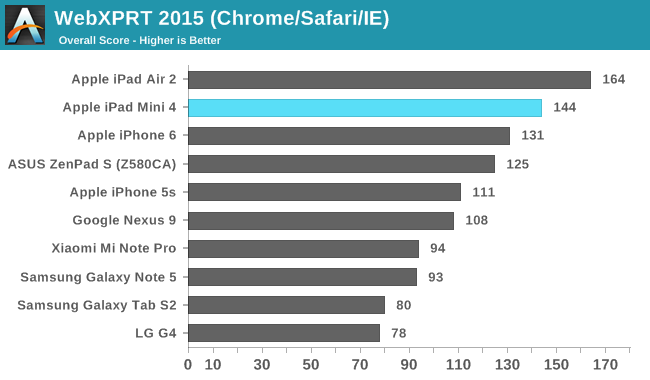
The interesting thing about JavaScript performance is that it's often bound by the performance of a single core. In this case the iPad Mini 4 does very well, and there's not a large gap between it and the iPad Air 2 despite the doubled L2 cache and additional core on the latter's A8X SoC. You certainly don't see anything even remotely close to a 50% lead for the Air 2 even though in a theoretical case where all cores are used entirely it would be 50% faster.

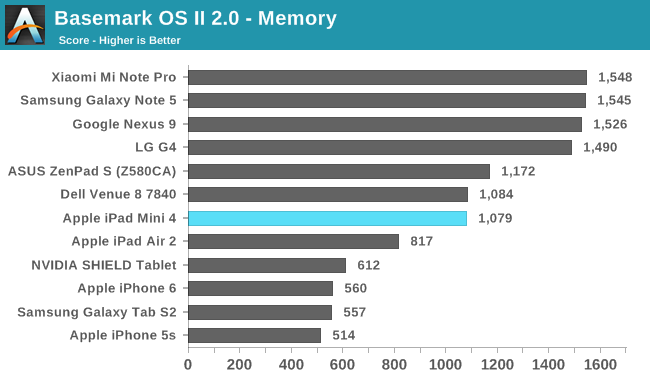
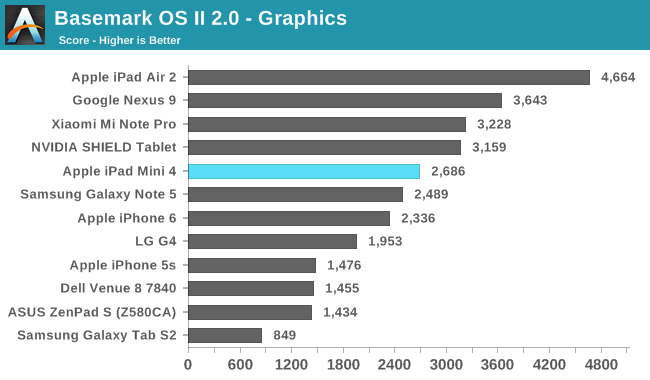
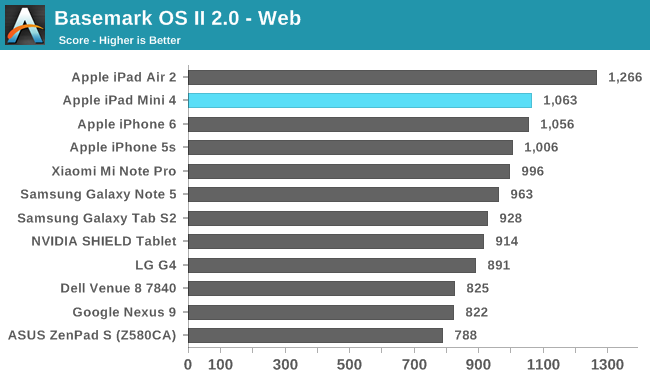
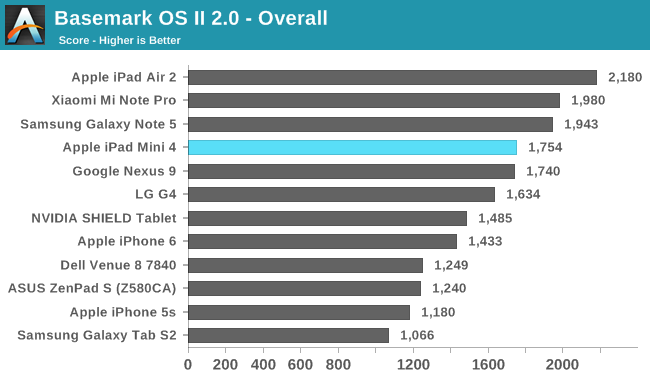
In BaseMark OS II's overall score the iPad Mini 4 is sitting right next to the Nexus 9, and both are relatively far below the iPad Air 2. However, it's important to analyze each sub test to see what areas a device excels at. Although it's right next to the Nexus 9 overall, the iPad Mini is significantly better in the system and web performance tests, while it falls behind in flash memory speed and graphics. Compared to the iPad Air 2 the Mini 4 falls behind in every test except for memory where it has a surprising lead. Looking at each test specifically, there's a tiny gap in web performance which echoes the results of our dedicated JavaScript benchmarks, and much larger gaps in system and GPU performance which makes sense as BaseMark OS II is designed in such a way that it will fully take advantage of A8X's triple core CPU and custom GXA6850 GPU in order to characterize their performance.
Overall I think the iPad Mini 4's general performance is right where it needs to be for a $399 small tablet. If you look at the results of the iPhone 5s you see that there is a significant gap between them in every test. The performance leap coming from the iPad Mini 3 certainly isn't like the leap that the original iPad Mini to iPad Mini 2 was when Apple moved directly from their A5 SoC to A7, but there's still a healthy improvement in performance across the board.
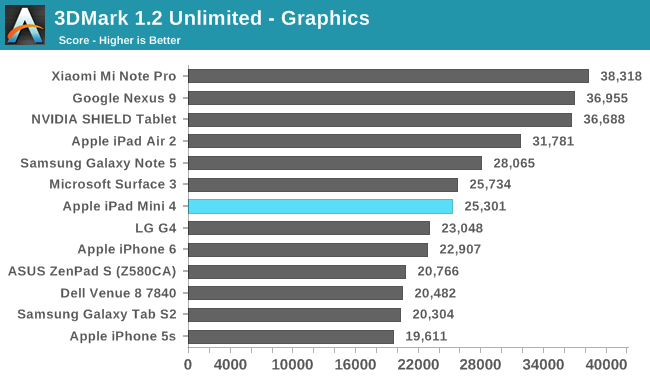

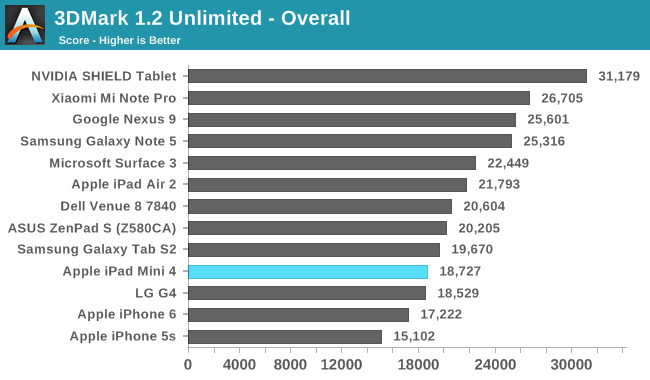
In 3DMark's overall score as well as both sub tests there's a small but noticeable gap between the Mini 4 and the iPhone 6. In the graphics test the Mini 4 is about 10% faster, while in the physics test the gap is a bit smaller at around 6%. The higher clocked CPU and GPU are definitely visible here, but the gap between the Mini 4's A8 SoC and the one in the iPhone 6 isn't enormous.
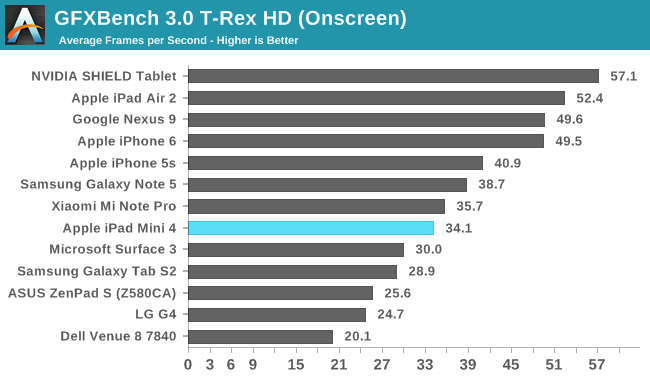
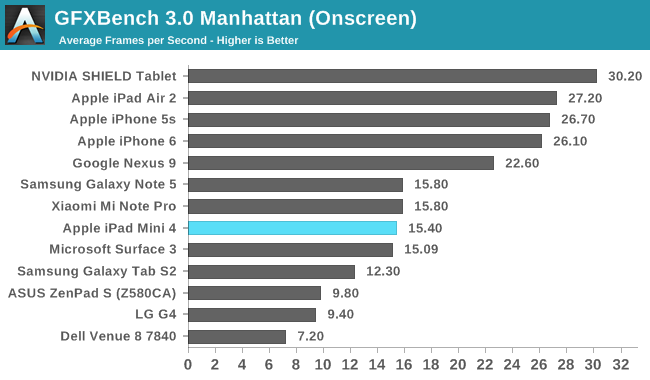
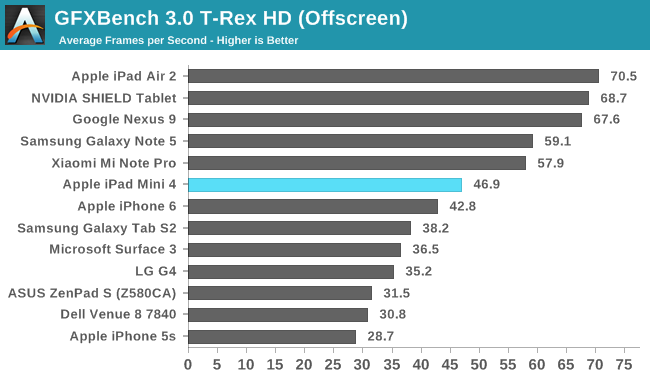

In GFXBench 3 the Mini 4 does pull ahead of the iPhone 6 when considering off screen 1080p performance, although with on screen performance the iPhone is much faster due to its lower resolution display. The level of graphical fidelity in the Manhattan benchmark is still too great to run consistently smoothly on the Mini at its native resolution, although a game with the visual quality of the T-Rex HD test would be playable at 2048x1536.
As I said earlier, the Mini 4's GPU performance is certainly not at the same level as the Nexus 9 or the iPad Air 2, but for a $399 8" tablet I think it's more than sufficient. One interesting point of comparison is the SHIELD Tablet, which was only $299 and has a very large lead over the Mini 4 as a result of its mobile Kepler GPU. It's also worth noting that while the Tab S2 model I reviewed was the 9.7" model, the 8.0" version should have identical results, and so the Mini 4 does have a decent lead over that. In the end the Mini 4 would have class-leading GPU performance if it weren't for the SHIELD Tablet, and NVIDIA definitely deserves credit for the level of GPU performance they were able to put into an 8" tablet. Even so, the Mini 4's GPU isn't going to have any trouble running the 3D apps or games on the App Store.
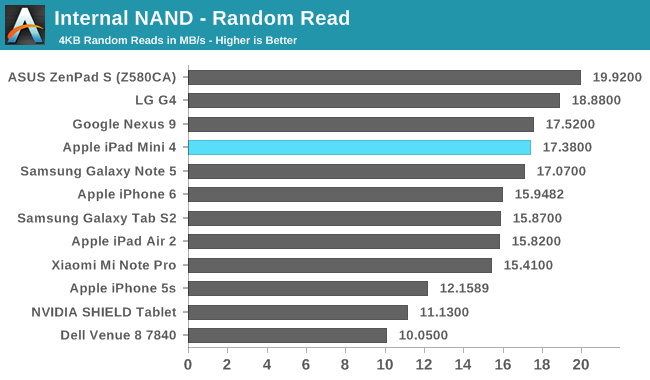
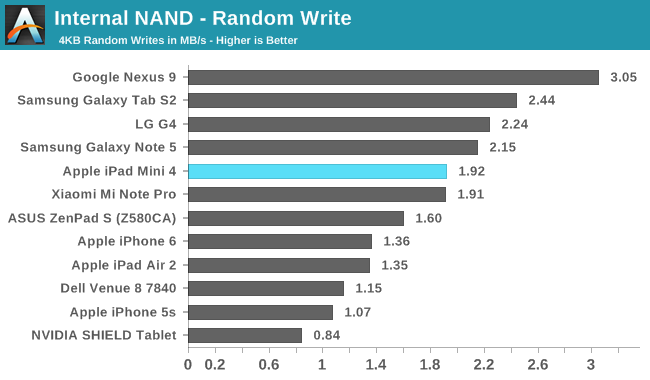
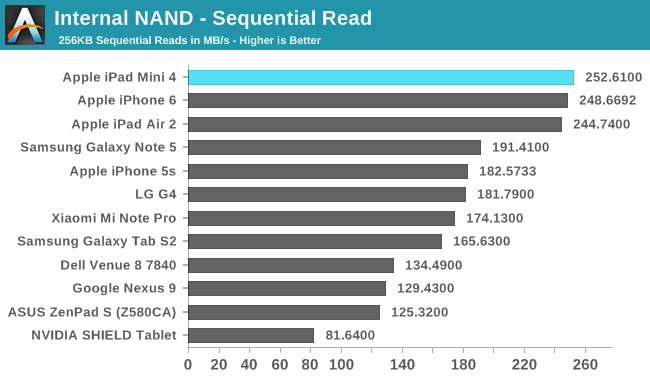
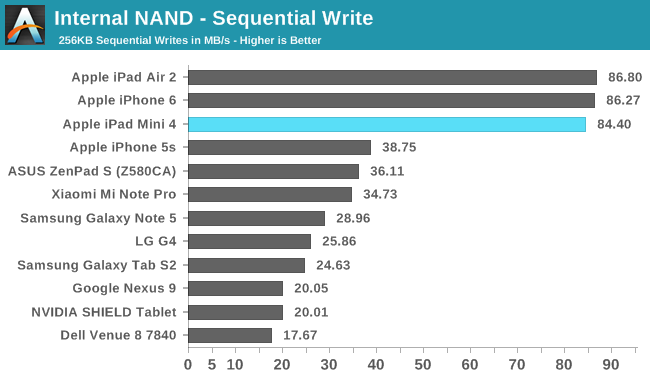
Storage performance on the iPad Mini 4 is where one would expect it to be. As usual, Apple excels when it comes to sequential reads and writes due to the use of SLC caching, with random read and write speeds also being very good, although not the best that we've seen on mobile devices. It's worth noting that my test model is a 128GB unit, and storage performance will be lower to some degree on the 64GB and 16GB models as flash storage uses parallelism heavily to improve performance by writing to multiple dies, and with a smaller storage capacity you have fewer dies to write to.










98 Comments
View All Comments
tipoo - Wednesday, October 28, 2015 - link
I wonder if this is pretty much what we can expect from the A8 in the ATV 4. Though it has a heatsink and no battery requirements, so it could go a bit further if they were arsed. Anything coming on that, AT team?Spectrophobic - Wednesday, October 28, 2015 - link
It's a bit insulting that it uses the same SoC as the iPod Touch 6G. I would've preferred a underclocked A8X over a speed-bumped A8, mostly for the A8X's GPU. Considering the typical iPad user, this probably wouldn't be much of an issue as the A8 is still a fast SoC for the mundane things people do.Tech_guy - Wednesday, October 28, 2015 - link
Yeah the GPU in the A8 wasn't designed to push this many pixels. And I hate paying a premium for a year old chip.NetMage - Saturday, October 31, 2015 - link
Paying a premium over what?denem - Wednesday, October 28, 2015 - link
iPad Air Mini 4 should have shipped with an A9 processor, a, TouchID 2 sensor, and, IMO, debuted before the iPhone 6s. The iPad 2 for example introduced the A5 months before the 4s. It was Apple’s most significant platform move ‘evah’. Here is our new technology. This is exciting!“iPad is our most advanced technology in a magical and revolutionary device at an unbelievable price” Steve Job, Jan 28 2010. ‘Magical and Revolutionary’ are smoke and mirrors, but from the iPad 3, the formula became last years technology and yesteryears design. Serviceable? Yes. Exciting? No.
Even when the Air 2 did have genuinely new/interesting advancements: the A8X and 2GB Ram, Apple could hardly bring themselves to talk about it. Nothing should be allowed to detract from the iPhone. If the iPad is less expensive, it must be inferior, or so the thinking goes. Even today, the iPad Pro, which matches iPhone pricing does not sport the new TouchID. Apple’s whole mindset is flawed. An IPad is not a substitute iPhone. Doh.
Tech_guy - Wednesday, October 28, 2015 - link
Yeah I would've bought it for sure with an A9 chip which they easily could've had considering they take less power than A8. The mini 4 GPU is the part that turned me off instantly. Iphone 6 plus GPU performance a year later. No thanks.denem - Thursday, October 29, 2015 - link
And let me guess, an A9 iPad would not have put you off from buying an iPhone if you needed one? No, hand me down technology does not impress anyone, but hey, let's kill enthusiasm and an entire product line while we are at it. Even the iPod got an A8 when it was still current. Bozos.denem - Thursday, October 29, 2015 - link
I guess I should have added that with 4x as many pixels to push, the mini 4's onscreen graphics are slower, a lot slower than the iPod 6. For example, the iPod 6 scores 41.7 fps onscreen for Manhattan HD, GFX Metal, while the iPad mini 4 pushes 15.7. (Source: arstechnica) Double plus stupid.Tech_guy - Thursday, October 29, 2015 - link
Yeah for the mini 4 to be taken seriously by me, a typical power user, it needed better hardware inside. It's literally the performance of an iPhone 6 plus graphics wise, which there's some instances where 6 plus dropped frames and lagged, even in the animations in iOS 9. I have yet to even go look at one because I was SO turned off by A8 rather than A8X or A9. Apple really did exactly everything they needed to do to chase me away from the iPad mini line, and iPad air 2 is too bulky in my personal opinion.akdj - Sunday, November 1, 2015 - link
You guys are hilarious. The A8 is t designed to push this many pixels (I'm writing this on iPad mini 4) but the A5 was? Or the A6x? The A7? I've got an iPad 4 as well as the Air 2 and I've used it daily since its release. It's awesome! Truly phenomenal. I've also used the mini 2 since it dropped. Killer tablet with excellent performance. Even today. It's using an A7 with identical resolution.That said, doubling the memory with the GPU & CPU share makes all the difference in the world. On the iPhone 6s, the Air 2 and now the mini 4.
I've got every triple A title ...if that's what you 'power users' are power using??? (I'm lost and I'm making money with mine!) from the App Store. Every. Single. One. There's not a single app or task i can perform on my Air 2 or iPhone 6s+ that I can't just as efficiently and quickly 'do, play, maiplulate read, consume, watch or produce' on the iPad mini 4. It's been through ten and twelve hour days with me the last few weeks and it's all the Air 2 is - I'll agree in a smaller package.
App developers are currently releasing apps aimed at the A5 & 6 as required hardware. Tomorrow that won't change and if anything will benefit the new mini ...as developers move into the 64bit minimum requirements of the first edition, the A7.
Thought as an actual user, consumer, producer, 'fellow power user?' (I've got a 15" MacBook Pro I typically use for heavy lifting but resources at thee largest tech and software companies in the world are now shifting ...in some cases 'more' resources to mobile than the desk. As a Creative Cloud subscriber since its inception, I'm floored by Adobe's mobile releases. They're incredible and work perfectly with Premier Pro, AE, PS and InDesign. IMHO MS could've left the iPad versions of Word, Excel, Power Point and One Note on v1. They're beyond awesome. I also fly (as a pilot) and rely on the iPad mini as my flight bag. It files my plans, tells me how much gas I need, weather and traffic conditions with up to date Jep charts, plates and NOTAMS. I'm not sure how much more power you're using than I am but there's simply no equal. Anywhere.
You guys all sound goofier than a three dollar bill. A month ago you couldn't get this package of performance. Today you can. It's lacking the A9, but has all other bases covered with display and doubling of RAM, incredible battery life and a smaller package yet YOU'VE got to have the might A9 or the three cores of the A8s ...when I'm absolutely sure as an owners of both you've NECER brought an Air 2 to its knees or limits. If so, please share (I'm aware of two limits on the Air 2 with apps currently available on iOS only ...any guesses?)
I'm honestly curious as to what constitutes a 'power user' of an iPad
Hilarious. Thanks for the laugh
K. Next
Ryan, it's Sunday bro!
:) I kid
Excellent write up as always. Many thanks
J